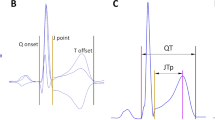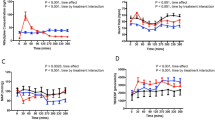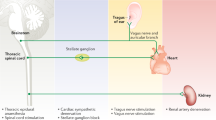Abstract
Heart rate is determined primarily by spontaneously repeating net inward current carried by sodium ions and potassium ions through hyperpolarization-activated cyclic-nucleotide-gated channels. Within the heart, these channels are found most abundantly in sinoatrial cardiomyocytes. The channels open in response to membrane hyperpolarization, modulated by local cAMP concentrations. They permit activation of the If current, which can be blocked specifically by molecules characterized by linked benzazepinone and benzocyclobutane rings, and which are devoid of effects on cardiac conduction, inotropy or peripheral vascular tone. The resulting heart-rate reduction has been effective in angina prevention in clinical trials involving 4,000 patients, using the prototype If inhibitor, ivabradine. No serious adverse events have been attributed to the treatment; the most prominent side-effect is dose-related, always reversible and often transient visual symptoms that seldom result in voluntary drug discontinuation.
This is a preview of subscription content, access via your institution
Access options
Subscribe to this journal
Receive 12 print issues and online access
$209.00 per year
only $17.42 per issue
Buy this article
- Purchase on Springer Link
- Instant access to full article PDF
Prices may be subject to local taxes which are calculated during checkout



Similar content being viewed by others
References
Habib G (2001) Is heart rate a risk factor in the general population? Dialogues Cardiovasc Med 6: 25–31
Goldberg R et al. (1996) Factors associated with survival to 75 years of age in middle-aged men and women: The Framingham Study. Arch Intern Med 156: 505–509
Gillum R (1988) The epidemiology of resting heart rate in a national sample of men and women: association with hypertension, coronary artery disasse, blood pressure, and other cardiovascular risk factors. Am Heart J 116: 163–174
Singh BN (2004) Impact of heart rate on cardiovascular disorders: focus on chronic stable angina. In Selective and Specific If Channel Inhibition in Cardiology, 25–36 (Ed., Fox K), London: Science Press Ltd
Kjekshus J and Gullestad L (1999) Heart rate as a therapeutic target in heart failure. Eur Heart J 1 (Suppl H): H64–H69
Kjekshus JK (1986) Importance of heart rate in determining beta-blocker efficacy in acute and long-term myocardial intervention trials. Am J Cardiol 57: 43F–49F
Levine HJ (1997) Rest heart rate and life expectancy. J Am Coll Cardiol 30: 1104–1106
DiFrancesco D (2004) If current inhibitors: properties of drug-channel interaction. In Selective and Specific If Channel Inhibition in Cardiology, 1–13 (Ed., Fox K), London: Science Press Ltd
DiFrancesco D (1985) The cardiac hyperpolarizing-activated current, If: origins and developments. Prog Biophys Molec Biol 46: 163–183
DiFrancesco D (1986) Characaterization of single pacemaker channels in cardiac sino-atrial node cells. Nature 324: 470–473
Management of stable angina pectoris. Recommendations of the Task Force of the European Society of Cardiology. (1997) Eur Heart J 18: 394–413
Gibbons RJ et al. (1999) ACC/AHA/ACP-ASIM guidelines for the management of patients with chronic stable angina: executive summary and recommendations. Circulation 99: 2829–2848
Williams SV et al. (2001) Guidelines for the management of patients with chronic stable angina: diagnosis and risk stratification. Ann Intern Med 135: 530–547
Pepine CJ et al. (1994) Characteristics of a contemporary population with angina pectoris: TIDES Investigators. Am J Cardiol 74: 226–231
Brown HF et al. (1979) How does adrenaline accelerate the heart? Nature 280: 235–236
DiFrancesco D and Tortora P (1991) Direct activation of cardiac pacemaker channels by intracellular cyclic AMP. Nature 351: 145–147
Ludwig A et al. (1998) A family of hyperpolarization-activated mammalian cation channels. Nature 393: 587–591
DiFrancesco D and Tromba C (1988) Inhibition of the hyperpolarization activated current (If) induced by acetylcholine in rabbit sino-atrial node myocytes. J Physiol (Lond) 405: 477–491
DiFrancesco D (1991) The contribution of the “pace-maker” current (If) to generation of spontaneous activity in rabbit sino-atrial node myocytes. J Physiol 434: 23–40
Colin P et al. (2003) Contributions of heart rate and contractility to myocardial oxygen balance during exercise. Am J Physiol Heart Circ Physiol 284: H676–H682
Colin P et al. (2004) Effect of graded heart rate reduction with ivabradine on myocardial oxygen consumption and diastolic time in exercising dogs. J Pharmacol Exp Ther 308: 236–240
Heidland UE and Strauer BE (2001) Left ventricular muscle mass and elevated heart rate are associated with coronary plaque disruption. Circulation 104: 1477–1482
Colin P et al. (2002) Differential effects of heart rate reduction and beta-blockade on left ventricular relaxation during exercise. Am J Physiol Heart Circ Physiol 282: H672–H679
Simon L et al. (1995) Coronary and haemodynamic effects of S 16257, a new bradycardic agent, in resting and exercising conscious dogs. J Pharmacol Exp Ther 275: 659–666
Mulder P et al. (2004) Long-term heart rate reduction induced by the selective I(f) current inhibitor ivabradine improves left ventricular function and intrinsic myocardial structure in congestive heart failure. Circulation 109: 1674–1679
Ramahi TM (2000) Beta blocker therapy for chronic heart failure. Am Fam Physician 62: 2267–2274
Tattersfield AE (1991) Respiratory function in the elderly and the effects of beta blockade. Cardiovasc Drugs Ther 4 (suppl 6): 1229–1232
Reneland R et al. (2000) Induction of insulin resistance by beta blockade but not ACE-inhibition: long-term treatment with atenolol or trandolapril. J Hum Hypertens 14: 175–180
Krone W and Nagele H (1988) Effects of antihypertensives on plasma lipids and lipoprotein metabolism. Am Heart J 116: 1729–1734
Lewis RV and Lofthouse C (1993) Adverse reactions with beta-adrenoceptor blocking drugs: an update. Drug Safety 9: 272–279
Egstrup K (1988) Transient myocardial ischemia after abrupt withdrawal of antianginal therapy in chronic stable angina. Am J Cardiol 61: 1219–1222
Frishman WH and Sica DA (2003) Calcium channel blockers. In Cardiovascular Pharmacotherapies, 2nd edn, 105–130 (Eds, Frishman WH et al.), New York: McGraw-Hill
Abrams J and Frishman WH (2003) The organic nitrates and nitroprusside. In Cardiovascular Pharmacotherapies, 2nd edn, 203–214 (Eds, Frishman WH et al.), New York: McGraw-Hill
Steering Committee, Transdermal Nitroglycerin Cooperative Study (1991) Acute and chronic antianginal efficacy in continuous twenty-four hour application of transdermal nitroglycerin. Am J Cardiol 68: 1263–1270
Frishman WH et al. (1995) Addition of zatebradine, a direct sinus node inhibitor, provides no greater exercise tolerance benefit in patients with angina taking extended-release nifedipine: results of a multicenter, randomised, double-blind, placebo-controlled, parallel-group study. J Am Coll Cardiol 26: 305–312
Thollon C et al. (1994) Electrophysiological effects of S 16257, a novel sino-atrial node modulator, on rabbit and guinea pig-cardiac preparations: comparison with UL-FS 49. Br J Pharmacol 112: 37–42
Bois P et al. (1996) Mode of action of bradycardic agent, S16257, on ionic currents of rabbit sinoatrial node cells. Br J Pharmacol 118: 1051–1057
Bucchi A et al. (2002) Current-dependent block of rabbit sino-atrial node If channels by ivabradine. J Gen Physiol 120: 1–13
Monnet X et al. (2001) Effect of heart rate reduction with ivabradine on exercise induced myocardial ischaemia and stunning. J Pharmacol Exp Ther 299: 1133–1139
Vilaine JP et al. (2003) Anti-ischemic effects of ivabradine, a selective heart rate-reducing agent, in exercise-induced myocardial ischemia in pigs. J Cardiovasc Pharmacol 42: 688–696
Moore N et al. (1998) Effects of a pure bradycardic agent, S 16257, at rest and during exercise in healthy volunteers: comparison with propranolol. Br J Clin Pharmacol 45: 188–189
Manz M et al. (2003) A single intravenous dose of ivabradine, a novel I(f) inhibitor, lowers heart rate but does not depress left ventricular function in patients with left ventricular dysfunction. Cardiology 100: 149–155
DiFrancesco D and Camm J (2004) Heart rate lowering by specific and selective If current inhibition with ivabradine: a new therapeutic perspective in cardiovascular disease. Drugs 64: 1757–1765
Borer JS Development of cardiovascular drugs: the US regulatory milieu from the perspective of a participating nonregulator. J Am Coll Cardiol, in press
Borer JS et al., for the European Ivabradine Investigators (2003) Anti-anginal and anti-ischemic effects of ivabradine, an If inhibitor, in stable angina: a randomized, double-blinded, multicentered, placebo-controlled trial. Circulation 107: 817–823
Borer JS (2004) New perspectives for the treatment of stable angina. In Selective and Specific If Channel Inhibition in Cardiology, 51–62 (Ed., Fox K), London: Science Press Ltd
Tardif JC et al., on behalf of the INITIATIVE study investigators (2003) Anti-anginal and anti-ischaemic effects of the If current inhibitor ivabradine compared to atenolol as monotherapies in patients with chronic stable angina. A 4-month randomised, double-blinded, multicenter, controlled non-inferiority trial [abstract]. Eur J Cardiol
Author information
Authors and Affiliations
Corresponding author
Ethics declarations
Competing interests
JS Borer serves as a paid consultant to Servier Laboratoires, Neuilly sur Seine, France.
Rights and permissions
About this article
Cite this article
Borer, J. Drug Insight: If inhibitors as specific heart-rate-reducing agents. Nat Rev Cardiol 1, 103–109 (2004). https://doi.org/10.1038/ncpcardio0052
Received:
Accepted:
Issue Date:
DOI: https://doi.org/10.1038/ncpcardio0052
This article is cited by
-
Intravenous ivabradine versus placebo in patients with low cardiac output syndrome treated by dobutamine after elective coronary artery bypass surgery: a phase 2 exploratory randomized controlled trial
Critical Care (2018)
-
Novel drugs for heart rate control in heart failure
Heart Failure Reviews (2018)
-
I(f) current channel inhibitor (ivabradine) deserves cardioprotective effect via down-regulating the expression of matrix metalloproteinase (MMP)-2 and attenuating apoptosis in diabetic mice
BMC Cardiovascular Disorders (2014)
-
Ivabradine: potential clinical applications in critically ill patients
Clinical Research in Cardiology (2013)
-
Exploring HCN channels as novel drug targets
Nature Reviews Drug Discovery (2011)



